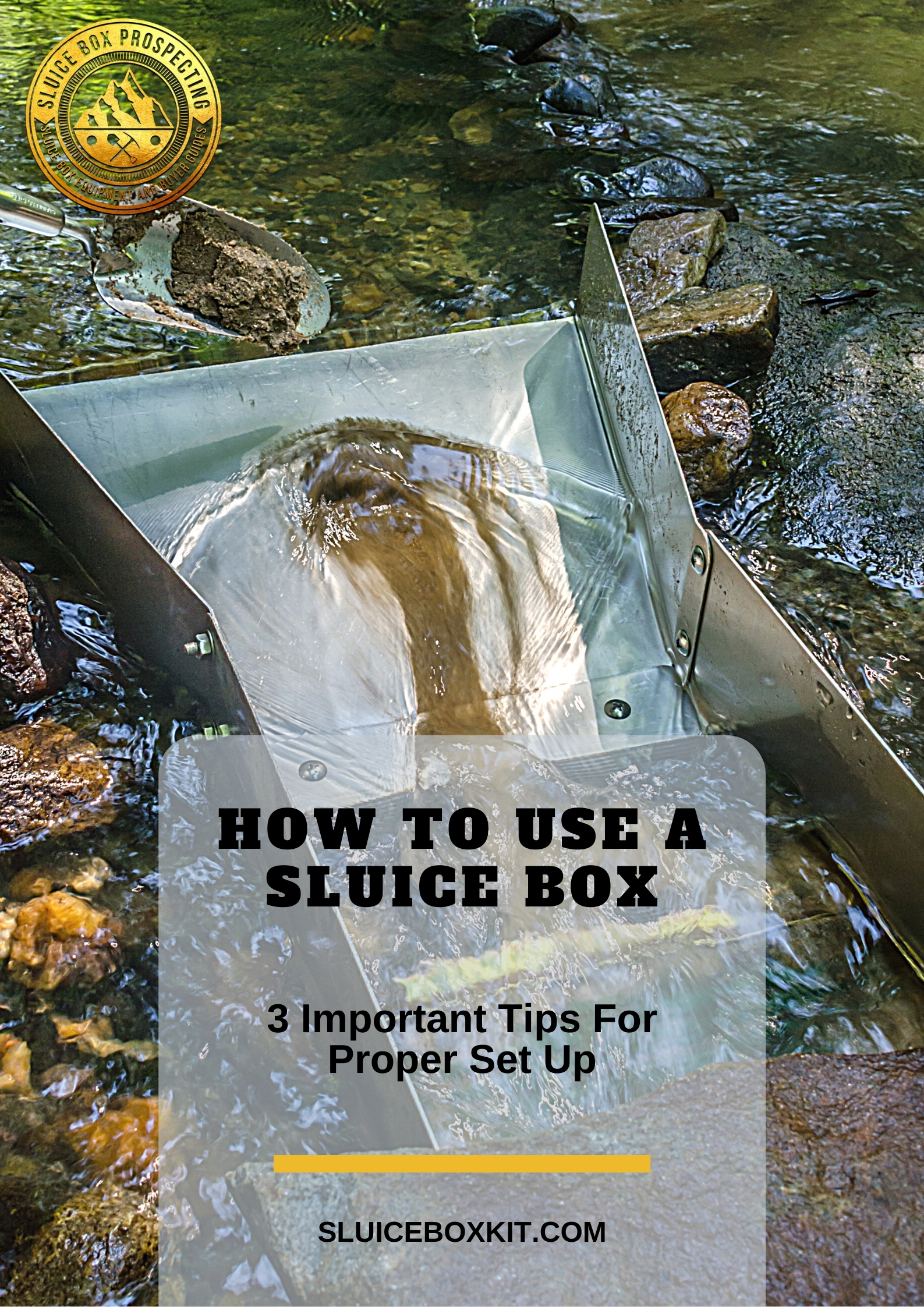Professional gold miners and hobbyists alike will usually utilize sluice boxes for them to collect gold from streams. Sluice boxes, when used correctly, can efficiently collect gold for you, giving you an effortless gold-mining operation.
To use sluice boxes correctly, you need to know how it is set up, functions, and best use in certain situations. There are a lot of factors that can make or break the efficiency of your gold-mining operation.
Below is a brief and basic guide to what sluice boxes are and what you can do to make them more efficient in catching gold. This includes looking into sluice box components, such as the riffle, carpet, and matting, the degree it should be set, as well as looking into the rate of water flowing through your sluice box.
How To Use Sluice Box For Best Results
Table of Contents
How Does a Sluice Box Capture Gold?
A sluice box is designed to capture gold effectively. A sluice box is designed to have several traps across the length designed to hinder and slow down the flow of water so that it can filter out gold.
As the traps slow down the water, it will be more effective for the sluice box to catch gold. The water will continuously flow to the bottom section of the sluice box while also sort out the heavier materials that may go through the box.
The mechanism that allows water to slow down to capture the gold flowing through them is called riffles. Riffles occasionally come in a variety of forms, which include:
- Blankets
- Longitudinal Riffles
- Hungarian Riffle
- Mercury Traps
- Lazy-L
- Expanded Metal
However, the most common riffle you will find in sluice boxes is the Hungarian riffle or the lazy-L riffle.
In some cases, some of the gold materials may bypass the riffle. If that is the case, sluice boxes also have mattings and carpets installed as a second “safety net” mechanism. These matting and carpets that come with the sluice boxes are specifically designed to capture the gold that skips the riffle as it flows through the surface of the mattings or carpet.
One of the most common types of matting or carpet you will find on sluice boxes is one called Miner’s moss. The Miner’s Moss is made up of woven fibers. Like the name, the woven fibers are designed to look similar to moss, hence the name. Like natural moss, Miner’s Moss can filter the flowing water to catch the finest and smallest gold. The gold would not pass through the moss’ fibers, trapping it in the process.
How To Use Sluice Box Step By Step
Once you identify an area with potential for finding gold, which will require research and investigation, you’ll want to follow the basics of using a sluice box outlined below:
1. Place the sluice parallel in a shallow area that has a good flow of water. You do not want whitewater flowing through the sluice, as you will more than likely lose material due to the fast flow of water.
2. Ensure that the bottom of the sluice is angled slightly lower than the gate of the box. Adjust the angle as needed to ensure that the water is not flowing too quickly over it. Set the slope at one inch of drop for every foot of the box’s length as a general rule.
3. Most prospectors recommend classifying the materials before running them through the sluice. To do this, accumulate material from the area you want to search in buckets or troughs. Next, run it through a coarse screen to remove larger rocks and unnecessary materials.
4. After classifying, begin to add the material to the front of the box slowly. Eventually, you will need to check what has accumulated on the bottom of the carpet. Carefully lift the box, keeping it horizontally level as you remove it from the water.
5. Identify any larger pieces of gold and remove them using tweezers. Next, remove the carpet and thoroughly wash and clean the accumulated materials into a bucket. If using carpet, allow it to dry first. This will make it easier for gold to fall from the fibers loosely. Also, be sure to carefully wash down all parts of the riffles and box into the bucket too.
6. Finally, process the material using a pan to recover valuable gold and minerals.
What Degree Should a Sluice Box Be Set At?
Depending on the length, you should set the sluice box between five to seven degrees. This allows bigger materials, such as rocks, pebbles, and small stones, to pass through easily without getting stuck on the sluice. But once again, this should depend on what length of sluice you have.
Miners would utilize sluice boxes that were at least 12 feet long. Usually, gold miners and prospectors alike would use the following types of sluice boxes:
- Wooden Sluice Boxes
- Plastic Sluice Boxes
- Metal Sluice Boxes
Wooden sluices were prominently used in the 19th century. Modern sluices are made either with plastic or metal and are usually between 24 to 48 inches long and between six to 10 inches wide.
Another good tip to those who want to set the sluice box right is to set them one inch per foot of drop. Always keep this tip in mind and alter it as you see fit and when you need to. If you set it too steep of an angle, the gold would likely wash right out of the sluice box.
Reminding once more, positioning the sluice box in a running stream is key to working efficiently to catch gold. Position it in a way that the water flows through the sluice box where it separates both dirt, rocks, and other materials while cleaning for the gold.
Since gold is usually heavier than the other debris, the gold will sink and stay at the bottom of the sluice. Specifically, it will be filtered by Miner’s Moss.
How Much Water Should You Have Running Through the Sluice Box?
Having the right amount of water running through the sluice box is very crucial to your gold-collecting operation. If too much water flows through the sluice box, you will find out that fine gold will be going through the sluice box. Also, if there is too little water going through the sluice box, smaller and lighter materials will usually clog the riffle as well as the carpet.
Remember to have enough water flowing through the sluice box to keep it clean and operational. Another thing that you should keep in mind is to make sure that the bed of the sluice box does not get completely covered by sand.
And finally, make sure the flow of the water is not too strong. If white froth begins to come out when the water flows over the riffles, then dampen it or place your sluice box in another stream. Just ensure that the water flow rate will allow lighter materials, such as fine gold, to run through the sluice box.
However, keep in mind the type of sluice box you have as it is an important factor. Depending on your sluice box, the amount of water needed to run through will be different.
For a review of the best sluice boxes available, check out the post: The Ultimate Sluice Box Review And Buyer Guide.
For example, if you have a sluice box with a short riffle, you need less water to run through the sluice box to have function properly. However, if you have a sluice box with higher riffles, you will require more water to catch gold better.
10 Additional Tips For Using A Sluice Box Successfully
Achieve more gold mining success by applying the following tips when using a sluice box:
- Classify (remove) larger rocks before running material through your sluice box.
- Consider upgrading your carpets and mats to miner’s moss.
- Break down heavy materials like clay to help ensure the gold is free to process.
- Feed the sluice box and a slow yet steady pace. This will help ensure that the riffles are doing their job of catching the gold.
- Avoid whitewater flowing through your box. Be careful to make sure that the flow of water is at a moderate pace and functioning properly.
- If working all day, clean your sluice box throughout the day to ensure that everything continues to function correctly.
- Pay attention to the amount of sand accumulated within the riffles; if it is heavy or extending into the next lower set of riffles, clean it.
- Clean your box using a bucket and lots of water. Take care to place the box into the bucket, ensuring you don’t tip materials from the sluice. Use lots of water to rinse the box and know that gold will sink to the bottom.
- Take time to research evidence of gold in the area that you’d like to prospect. Use google, the library, and local historians to discover areas of potential.
- Familiarize yourself with the gold prospecting laws. Never trespass and always ask permission to prospect on land that you do not own.
How To Use Sluice Box Conclusion
The sluice box can effectively collect gold for you as long as you know how to set it up effectively. Once more, make sure you know how to set up your sluice box efficiently in the water. The angle makes all the differences. Furthermore, make sure that the rate of water is also suitable for your sluice box; otherwise, it will not catch the materials properly. Follow these tips, and you’ll be collecting a lot of gold in no time.

